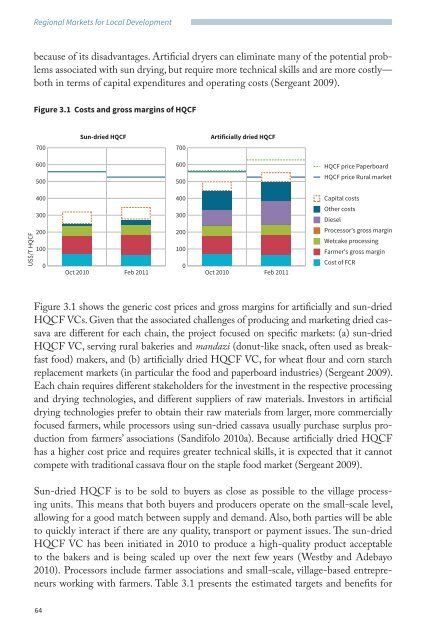Regional Markets
56ec00c44c641_local-markets-book_complete_LR
56ec00c44c641_local-markets-book_complete_LR
Create successful ePaper yourself
Turn your PDF publications into a flip-book with our unique Google optimized e-Paper software.
<strong>Regional</strong> <strong>Markets</strong> for Local Development<br />
because of its disadvantages. Artificial dryers can eliminate many of the potential problems<br />
associated with sun drying, but require more technical skills and are more costly—<br />
both in terms of capital expenditures and operating costs (Sergeant 2009).<br />
Figure 3.1 Costs and gross margins of HQCF<br />
700<br />
Sun-dried HQCF<br />
700<br />
Artificially dried HQCF<br />
600<br />
500<br />
600<br />
500<br />
HQCF price Paperboard<br />
HQCF price Rural market<br />
US$/T HQCF<br />
400<br />
300<br />
200<br />
100<br />
0<br />
Oct 2010<br />
Feb 2011<br />
400<br />
300<br />
200<br />
100<br />
0<br />
Oct 2010<br />
Feb 2011<br />
Capital costs<br />
Other costs<br />
Diesel<br />
Processor's gross margin<br />
Wetcake processing<br />
Farmer's gross margin<br />
Cost of FCR<br />
Figure 3.1 shows the generic cost prices and gross margins for artificially and sun-dried<br />
HQCF VCs. Given that the associated challenges of producing and marketing dried cassava<br />
are different for each chain, the project focused on specific markets: (a) sun-dried<br />
HQCF VC, serving rural bakeries and mandazi (donut-like snack, often used as breakfast<br />
food) makers, and (b) artificially dried HQCF VC, for wheat flour and corn starch<br />
replacement markets (in particular the food and paperboard industries) (Sergeant 2009).<br />
Each chain requires different stakeholders for the investment in the respective processing<br />
and drying technologies, and different suppliers of raw materials. Investors in artificial<br />
drying technologies prefer to obtain their raw materials from larger, more commercially<br />
focused farmers, while processors using sun-dried cassava usually purchase surplus production<br />
from farmers’ associations (Sandifolo 2010a). Because artificially dried HQCF<br />
has a higher cost price and requires greater technical skills, it is expected that it cannot<br />
compete with traditional cassava flour on the staple food market (Sergeant 2009).<br />
Sun-dried HQCF is to be sold to buyers as close as possible to the village processing<br />
units. This means that both buyers and producers operate on the small-scale level,<br />
allowing for a good match between supply and demand. Also, both parties will be able<br />
to quickly interact if there are any quality, transport or payment issues. The sun-dried<br />
HQCF VC has been initiated in 2010 to produce a high-quality product acceptable<br />
to the bakers and is being scaled up over the next few years (Westby and Adebayo<br />
2010). Processors include farmer associations and small-scale, village-based entrepreneurs<br />
working with farmers. Table 3.1 presents the estimated targets and benefits for<br />
64


